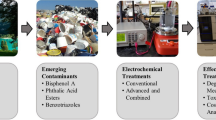Abstract
Global production of paint generates a large volume of waste which affects human health and creates an environmental burden. The purpose of this study has been the evaluation of the performance and the control of the efficiency of a hybrid electro-thermochemical wastewater treatment technology able to transform dissolved pollutants into metal oxide/carbide powders and to produce water ready to be reused in manufacturing cycles. In this study, simple and fast method based on liquid–liquid extraction combined with gas chromatography–mass spectrometry has been proposed for the identification of environmental pollutants in industrial water effluents. Parameters affecting the liquid–liquid extraction efficiency were thoroughly studied to ensure high accuracy and precision of the method. The proposed method was successfully applied to the identification and determination of markers levels in a comparison study between the original and treated water effluents. Removal efficiency factors were defined and the power of removal was discussed in terms of weak, moderate, and significant markers removal. The evaluation showed significant removal of markers in water treatment processes employing various additives.
Graphical abstract






Similar content being viewed by others
References
Kong Z, Li L, Xue Y, Yang M, Li YY (2019) J Clean Prod 231:913
Subki NS, Akhir NM, Halim NSA, Yusoff NRN (2020) IOP Conf Ser Earth Environ Sci 549:012066
Sun Y, Zhou S, Sun W, Zhu S, Zheng H (2020) Sep Purif Technol 241:116737
Li J, Pham AN, Dai R, Wan Z, Waite TD (2020) J Hazard Mater 392:122261
Sheth Y, Dharaskar S, Khalid M, Sonawane S (2021) Sustain Energy Tech 43:100951
Gondal MA, Hussain T (2007) Talanta 71:73
Mohsen AELS, Hasanin EA, Kamel MM (2010) Am Eurasian J Agric Environ Sci 8:597
Vishali S, Roshini SK, Samyuktha MR, Ashish K (2018) Environ Monit Assess 190:587
Monga D, Basu S (2019) Adv Powder Technol 30:1089
Wang Y, Ding K, Xu R, Yu D, Wang W, Gao P, Li B (2020) J Clean Prod 247:119108
Sharma S, Simsek H (2019) Chemosphere 221:630
Ahmad T, Belwal T, Li L, Ramola S, Aadil RM, Xu Y, Zisheng L (2020) Trends Food Sci Tech 99:21
An C, Huang G, Yao Y, Zhao S (2017) Sci Total Environ 579:537
Ahmad M, Bajahlan AS, Hammad WS (2008) Environ Monit Assess 147:297
Makoś P, Przyjazny A, Boczkaj G (2018) J Chromatogr A 1570:28
Pothitou P, Voutsa D (2008) Chemosphere 73:1716
Nurerk P, Llompart M, Donkhampa P, Bunkoed O, Dagnac T (2020) J Chromatogr A 1610:460564
Randall PM (1992) J Hazard Mater 29:2755
Noruzman AH, Apandi NM (2020) J Adv Res Bus Managem Stud 20:28
Krithika D, Philip L (2016) Int Biodeter Biodegr 107:31
Lin KF (2016) Alkyd resins. Kirk-othmer encyclopedia of chemical technology. John Wiley and Sons, New Jersey
Dalgaard M, Hass U, Vinggaard AM, Jarfelt K, Lam HR, Sørensen IK, Sommer HM, Ladefoged O (2013) Reprod Toxicol 17:163
Ghisari M, Bonefeld-Jorgensen EC (2009) Toxicol Lett 189:67
AbuGhazaleh AA, Riley MB, Thies EE (2005) J Dairy Sc 88:4334
Funding
This work was supported by the Slovak Research and Development Agency under the Contract No. APVV-19-0149. The work was supported by the Scientific Grant Agency of the Ministry of Education of the Slovak Republic (VEGA project no. 1/0412/20) and the Program for the Support of Excellent Teams of Young Researchers of STU.
Author information
Authors and Affiliations
Corresponding author
Additional information
Publisher's Note
Springer Nature remains neutral with regard to jurisdictional claims in published maps and institutional affiliations.
Rights and permissions
About this article
Cite this article
Szarka, A., Viktoryová, N., Horváth, G. et al. GC–MS methods for the evaluation of the performance of electrochemical water treatment for the degradation of pollutants from paint industry effluents. Monatsh Chem 153, 161–169 (2022). https://doi.org/10.1007/s00706-022-02890-3
Received:
Accepted:
Published:
Issue Date:
DOI: https://doi.org/10.1007/s00706-022-02890-3




